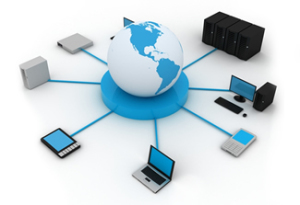 When you’re planning or working in a business that offers IT services to customers, you need to understand the interrelated parts of the IT infrastructure. In a nutshell, IT infrastructure is any business asset that contributes to delivering IT services, from hardware components to the tools used to design software. Businesses rely on the IT infrastructure to meet in-house IT-related needs as well as the needs of their clients and customers. There isn’t just one way to organize a business’s IT department; there are as many definitions of IT infrastructure as there are businesses that create value through technology.
When you’re planning or working in a business that offers IT services to customers, you need to understand the interrelated parts of the IT infrastructure. In a nutshell, IT infrastructure is any business asset that contributes to delivering IT services, from hardware components to the tools used to design software. Businesses rely on the IT infrastructure to meet in-house IT-related needs as well as the needs of their clients and customers. There isn’t just one way to organize a business’s IT department; there are as many definitions of IT infrastructure as there are businesses that create value through technology.
A simple way to break down a business’s IT infrastructure is by category. Equipment needed to deliver IT services goes into the services category. All IT hardware components go into the hardware category. Licensed software applications go into the purchased software category. Tools used to maintain IT software go into the software maintenance category, and tools used to design software go into the software development category. Depending on who you talk to, you may hear about another category for all the people needed to operate the tools and equipment, but not everybody considers people to be part of the IT infrastructure.
What Is IT Infrastructure Used For?
According to Galorath, there are two phases of IT operations, and they are the project phase and the ongoing operations phase. The project phase deals with setting up technology components with the goal of creating value, and the ongoing operations phase deals with all the upkeep of each project. Businesses maintain their IT infrastructures in order to make money delivering technological services and providing solutions to clients and customers. IT differs from management information systems in that IT seeks to create value through technology, and MIS uses technology to manage teams of people. IT is the application of computer science and networking to generate profits for businesses, and MIS is a kind of high-tech approach to management.
The hardware components in a typical IT infrastructure include servers, computers, Ethernet hubs, persistent storage, access points, gateways and any other equipment needed to provide computing and networking to a location. IT services also extend to software design, support and maintenance, as well as networking and database setup and support. A business’s IT department can be in charge of database administration as well as Web development and software design. The software created by an IT department isn’t meant to be sold to the public; it’s usually just simple software to be used internally by the business or its clients.
How to Design IT Infrastructure
When planning the responsibilities of the IT department, consider what services you will offer to your clients. If your services require your equipment to be loaned out for the duration of a project, plan to buy enough servers, racks, computers and components to complete as many projects as you anticipate having. However, don’t buy equipment only to have it sit in storage while you develop your IT services; consider renting equipment as your needs grow, and compare this cost to the money you would spend buying the necessary equipment.
Related Resource: Computer Science Jobs in Healthcare
While there is some disagreement over exactly what is included in IT infrastructure, the overwhelming consensus is that it allows businesses to make money offering IT services. The next time you plan an IT-related project, think about the value you’re creating with your IT infrastructure.
 Follow
Follow